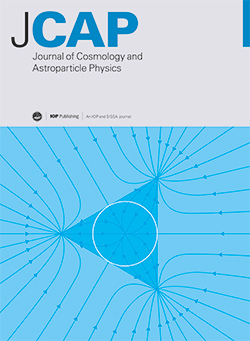Modulations of gravitational waves due to non-static gravitational lenses
IF 5.3
2区 物理与天体物理
Q1 ASTRONOMY & ASTROPHYSICS
Journal of Cosmology and Astroparticle Physics
Pub Date : 2025-04-23
DOI:10.1088/1475-7516/2025/04/069
引用次数: 0
Abstract
Gravitational waves (GWs) offer a new observational window into the universe, providing insights into compact objects and cosmic structures. Gravitational lensing, commonly studied in electromagnetic waves, also affects GWs, introducing magnification, time delays, and multiple images. While existing studies focus on static lenses, many astrophysical lenses are dynamic, with time-varying mass distributions such as moving stars or orbiting binaries. We develop a general theoretical framework to describe non-static lenses and demonstrate how they modulate GW signals, inducing unique time-varying amplitude modulations and spectral broadening. By examining uniformly moving and orbiting binary lenses, we show that these modulations provide new observational signatures, enhancing our understanding of lensing objects and the dynamics of the universe. Our findings have important implications for GW astronomy, offering novel ways to probe lens dynamics and improve the interpretations of GW signals.非静态引力透镜对引力波的调制
引力波(GWs)提供了一个观察宇宙的新窗口,提供了对紧凑物体和宇宙结构的见解。通常在电磁波中研究的引力透镜效应也会影响gw,带来放大、时间延迟和多重图像。虽然现有的研究集中在静态透镜上,但许多天体物理透镜是动态的,具有随时间变化的质量分布,如运动的恒星或轨道双星。我们开发了一个一般的理论框架来描述非静态透镜,并演示了它们如何调制GW信号,诱导独特的时变幅度调制和频谱展宽。通过检查均匀移动和轨道双星透镜,我们发现这些调制提供了新的观测特征,增强了我们对透镜物体和宇宙动力学的理解。我们的发现对GW天文学具有重要意义,提供了探索透镜动力学和改进GW信号解释的新方法。
本文章由计算机程序翻译,如有差异,请以英文原文为准。
求助全文
约1分钟内获得全文
求助全文
来源期刊

Journal of Cosmology and Astroparticle Physics
地学天文-天文与天体物理
CiteScore
10.20
自引率
23.40%
发文量
632
审稿时长
1 months
期刊介绍:
Journal of Cosmology and Astroparticle Physics (JCAP) encompasses theoretical, observational and experimental areas as well as computation and simulation. The journal covers the latest developments in the theory of all fundamental interactions and their cosmological implications (e.g. M-theory and cosmology, brane cosmology). JCAP''s coverage also includes topics such as formation, dynamics and clustering of galaxies, pre-galactic star formation, x-ray astronomy, radio astronomy, gravitational lensing, active galactic nuclei, intergalactic and interstellar matter.
 求助内容:
求助内容: 应助结果提醒方式:
应助结果提醒方式:


